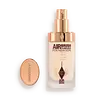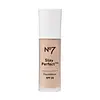What's inside
What's inside
 Key Ingredients
Key Ingredients

 Benefits
Benefits

 Concerns
Concerns

 Ingredients Side-by-side
Ingredients Side-by-side

Water
Skin ConditioningIsododecane
EmollientDimethicone
EmollientGlycerin
HumectantCetyl PEG/PPG-10/1 Dimethicone
EmulsifyingButylene Glycol Dicaprylate/Dicaprate
EmollientTrisiloxane
Skin ConditioningSilica
AbrasiveBis-Hydroxyethoxypropyl Dimethicone/Ipdi Copolymer Ethylcarbamate
Quaternium-90 Bentonite
Calcium Sodium Borosilicate
Di-C12-13 Alkyl Tartrate
EmollientDiisostearyl Malate
EmollientSorbitan Isostearate
EmulsifyingPhenoxyethanol
PreservativeSodium Chloride
MaskingAlcohol
AntimicrobialSaccharomyces Ferment
Skin ConditioningDimethicone Crosspolymer
Emulsion StabilisingMenthyl PCA
HumectantMarrubium Vulgare Extract
Skin ConditioningPotassium Sorbate
PreservativeSodium Dehydroacetate
PreservativeDextrin Palmitate
EmulsifyingAlumina
AbrasiveTriethoxycaprylylsilane
Dimethicone/Vinyl Dimethicone Crosspolymer
Skin ConditioningPolyphenylsilsesquioxane
C20-24 Olefin
Skin ConditioningPropylene Carbonate
SolventGlycogen
HumectantTocopheryl Acetate
AntioxidantIsomalt
HumectantLauroyl Lysine
Skin ConditioningCitric Acid
BufferingPentaerythrityl Tetra-Di-T-Butyl Hydroxyhydrocinnamate
AntioxidantPhytol
EmollientCI 77891
Cosmetic ColorantIron Oxides
Water, Isododecane, Dimethicone, Glycerin, Cetyl PEG/PPG-10/1 Dimethicone, Butylene Glycol Dicaprylate/Dicaprate, Trisiloxane, Silica, Bis-Hydroxyethoxypropyl Dimethicone/Ipdi Copolymer Ethylcarbamate, Quaternium-90 Bentonite, Calcium Sodium Borosilicate, Di-C12-13 Alkyl Tartrate, Diisostearyl Malate, Sorbitan Isostearate, Phenoxyethanol, Sodium Chloride, Alcohol, Saccharomyces Ferment, Dimethicone Crosspolymer, Menthyl PCA, Marrubium Vulgare Extract, Potassium Sorbate, Sodium Dehydroacetate, Dextrin Palmitate, Alumina, Triethoxycaprylylsilane, Dimethicone/Vinyl Dimethicone Crosspolymer, Polyphenylsilsesquioxane, C20-24 Olefin, Propylene Carbonate, Glycogen, Tocopheryl Acetate, Isomalt, Lauroyl Lysine, Citric Acid, Pentaerythrityl Tetra-Di-T-Butyl Hydroxyhydrocinnamate, Phytol, CI 77891, Iron Oxides
Water
Skin ConditioningCaprylyl Methicone
Skin ConditioningDimethicone
EmollientPhenyl Trimethicone
Skin ConditioningEthylhexyl Methoxycinnamate
UV AbsorberTrimethylsiloxysilicate
EmollientMica
Cosmetic ColorantSilica
AbrasivePEG-9 Dimethicone
Skin ConditioningTitanium Dioxide
Cosmetic ColorantBis-Isobutyl PEG/PPG-10/7/Dimethicone Copolymer
EmulsifyingButylene Glycol
HumectantDisteardimonium Hectorite
StabilisingMagnesium Sulfate
Phenoxyethanol
PreservativeTriethyl Citrate
MaskingPanthenol
Skin ConditioningTriethoxycaprylylsilane
Tocopheryl Acetate
AntioxidantCaprylyl Glycol
EmollientSodium Hyaluronate
HumectantEthylhexylglycerin
Skin ConditioningTetrasodium EDTA
BHT
AntioxidantCI 77891
Cosmetic ColorantCI 77492
Cosmetic ColorantCI 77491
Cosmetic ColorantCI 77499
Cosmetic ColorantWater, Caprylyl Methicone, Dimethicone, Phenyl Trimethicone, Ethylhexyl Methoxycinnamate, Trimethylsiloxysilicate, Mica, Silica, PEG-9 Dimethicone, Titanium Dioxide, Bis-Isobutyl PEG/PPG-10/7/Dimethicone Copolymer, Butylene Glycol, Disteardimonium Hectorite, Magnesium Sulfate, Phenoxyethanol, Triethyl Citrate, Panthenol, Triethoxycaprylylsilane, Tocopheryl Acetate, Caprylyl Glycol, Sodium Hyaluronate, Ethylhexylglycerin, Tetrasodium EDTA, BHT, CI 77891, CI 77492, CI 77491, CI 77499
Ingredients Explained
These ingredients are found in both products.
Ingredients higher up in an ingredient list are typically present in a larger amount.
Ci 77891 is a white pigment from Titanium dioxide. It is naturally found in minerals such as rutile and ilmenite.
It's main function is to add a white color to cosmetics. It can also be mixed with other colors to create different shades.
Ci 77891 is commonly found in sunscreens due to its ability to block UV rays.
Learn more about CI 77891Dimethicone is a type of synthetic silicone created from natural materials such as quartz.
What it does:
Dimethicone comes in different viscosities:
Depending on the viscosity, dimethicone has different properties.
Ingredients lists don't always show which type is used, so we recommend reaching out to the brand if you have questions about the viscosity.
This ingredient is unlikely to cause irritation because it does not get absorbed into skin. However, people with silicone allergies should be careful about using this ingredient.
Note: Dimethicone may contribute to pilling. This is because it is not oil or water soluble, so pilling may occur when layered with products. When mixed with heavy oils in a formula, the outcome is also quite greasy.
Learn more about DimethiconePhenoxyethanol is a preservative that has germicide, antimicrobial, and aromatic properties. Studies show that phenoxyethanol can prevent microbial growth. By itself, it has a scent that is similar to that of a rose.
It's often used in formulations along with Caprylyl Glycol to preserve the shelf life of products.
Silica, also known as silicon dioxide, is a naturally occurring mineral. It is used as a fine, spherical, and porous powder in cosmetics.
Though it has exfoliant properties, the function of silica varies depending on the product.
The unique structure of silica enhances the spreadability and adds smoothness, making it a great texture enhancer.
It is also used as an active carrier, emulsifier, and mattifier due to its ability to absorb excess oil.
In some products, tiny microneedles called spicules are made from silica or hydrolyzed sponge. When you rub them in, they lightly polish away dead skin layers and enhance the penetration of active ingredients.
Learn more about SilicaTocopheryl Acetate is AKA Vitamin E. It is an antioxidant and protects your skin from free radicals. Free radicals damage the skin by breaking down collagen.
One study found using Tocopheryl Acetate with Vitamin C decreased the number of sunburned cells.
Tocopheryl Acetate is commonly found in both skincare and dietary supplements.
Learn more about Tocopheryl AcetateTriethoxycaprylylsilane is a silicone used to bind and stabilize ingredients.
As an emulsifier, it helps prevent ingredients from separating. This can help elongate the shelf life of products.
Triethoxycaprylylsilane is often used to coat mineral sunscreens ingredients to help give a better feel. It also helps reduce oxidative stress in sunscreens.
Learn more about TriethoxycaprylylsilaneWater. It's the most common cosmetic ingredient of all. You'll usually see it at the top of ingredient lists, meaning that it makes up the largest part of the product.
So why is it so popular? Water most often acts as a solvent - this means that it helps dissolve other ingredients into the formulation.
You'll also recognize water as that liquid we all need to stay alive. If you see this, drink a glass of water. Stay hydrated!
Learn more about Water